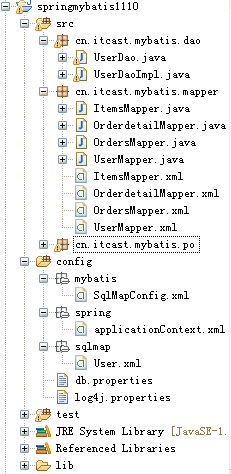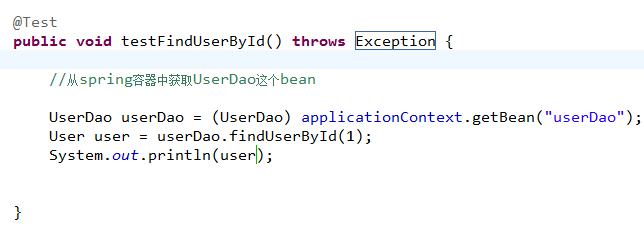1mybatis和spring整合 1.1 mybaits和spring整合的思路 1、让spring管理SqlSessionFactory 2、让spring管理mapper动态代理对象和dao。 使用spring和mybatis整合开发mapper代理及原始dao接口。 自动开启事务,自动关闭 sqlsession. 3、让spring管理数据源( 数据库连接池) 1.2创建整合工程


1.1加入jar包 1、mybatis3.2.7本身的jar包 2、数据库驱动包 3、spring3.2.0 4、spring和mybatis整合包 从mybatis的官方下载spring和mybatis整合包

1.1log4j.properties 1.2SqlMapconfig.xml mybatis配置文件:别名、settings,数据源不在这里配置 <!DOCTYPE configuration PUBLIC "-//mybatis.org//DTD Config 3.0//EN" "http://mybatis.org/dtd/mybatis-3-config.dtd"> <configuration> <!-- 定义 别名 --> <typeAliases> <!-- 批量别名定义 指定包路径,自动扫描包下边的pojo,定义别名,别名默认为类名(首字母小写或大写) --> <package name="cn.itcast.mybatis.po" /> </typeAliases> <mappers> <!-- 加载原始dao使用的user.xml --> <mapper resource="sqlmap/User.xml"/> <package name="cn.itcast.mybatis.mapper" /> </mappers> </configuration> 1.3 applicationContext.xml 1、数据源(dbcp连接池) 2、SqlSessionFactory 3、mapper对象(bin)或dao 1.4整合开发原始dao接口 1.4.1配置SqlSessionFactory 在 applicationContext.xml配置SqlSessionFactory <!-- SqlsessionFactory --> <bean id="sqlSessionFactory" class="org.mybatis.spring.SqlSessionFactoryBean"> <!-- 数据源 --> <property name="dataSource" ref="dataSource"/> <!-- mybatis配置文件 --> <property name="configLocation" value="classpath:mybatis/SqlMapConfig.xml"/> </bean> <!-- 加载配置文件 --> <context:property-placeholder location="classpath:db.properties" /> <!-- 数据库连接池 --> <bean id="dataSource" class="org.apache.commons.dbcp.BasicDataSource" destroy-method="close"> <property name="driverClassName" value="${jdbc.driver}" /> <property name="url" value="${jdbc.url}" /> <property name="username" value="${jdbc.username}" /> <property name="password" value="${jdbc.password}" /> <property name="maxActive" value="10" /> <property name="maxIdle" value="5" /> </bean> db.properties: jdbc.driver=com.mysql.jdbc.Driver jdbc.url=jdbc:mysql://localhost:3306/mybatis jdbc.username=root jdbc.password=mysql 1.4.2开发dao public class UserDaoImpl extends SqlSessionDaoSupport implements UserDao { @Override public User findUserById(int id) throws Exception { // 创建SqlSession SqlSession sqlSession = this.getSqlSession();//getSqlSession从SqlSessionDaoSupport 获取 // 根据id查询用户信息 User user = sqlSession.selectOne("test.findUserById", id); return user; } } 1.4.3applicationContext.xml配置 dao <!-- 配置dao --> <bean id="userDao" class="cn.itcast.mybatis.dao.UserDaoImpl"> <property name="sqlSessionFactory" ref="sqlSessionFactory"/> </bean> 1.4.4测试dao接口

1.1整合开发mapper代理方法 (mapper开发只写接口不写实现类,实现类由mybatis动态生成), 1.1.1开发mapper.xml和mapper.java

1.1.1applicationContext.xml使用MapperFactoryBean <!-- 配置mapper MapperFactoryBean:用于生成mapper代理对象,当有多个mapper的时候每一个mapper都要配置, --> <bean id="userMapper" class="org.mybatis.spring.mapper.MapperFactoryBean"> <property name="mapperInterface" value="cn.itcast.mybatis.mapper.UserMapper"/>全路径名 <property name="sqlSessionFactory" ref="sqlSessionFactory"/>没有整合spring的时候是通过sqlSessionFactory得到sqlSession再通过getMapper()方法, </bean> 使用此方法对于每个mapper都需要配置,比较繁琐。 1.1.2applicationContext.xml使用MapperScannerConfigurer(扫描mapper) <!-- MapperScannerConfigurer:mapper的扫描器,将包下边的mapper接口自动创建代理对象, 自动创建到spring容器中,bean的id是mapper的类名(首字母小写) --> <bean class="org.mybatis.spring.mapper.MapperScannerConfigurer"> <!-- 配置扫描包的路径 如果要扫描多个包,中间使用半角逗号分隔 --> <property name="basePackage" value="cn.itcast.mybatis.mapper"/> <!-- 使用sqlSessionFactoryBeanName --> <property name="sqlSessionFactoryBeanName" value="sqlSessionFactory"/> </bean> 使用扫描器自动扫描mapper,生成代理对象,比较方便。 1.1.3测试mapper接口

全部代码:
UserMapper
public interface UserMapper { //根据用户id查询用户信息 public User findUserById(int id) throws Exception; //根据用户名称 查询用户信息 public List<User> findUserByName(String username) throws Exception; //自定义查询条件查询用户信息 public List<User> findUserList(UserQueryVo userQueryVo) throws Exception; //查询用户,使用resultMap进行映射 public List<User> findUserListResultMap(UserQueryVo userQueryVo)throws Exception; //查询用户,返回记录个数 public int findUserCount(UserQueryVo userQueryVo) throws Exception; //插入用户 public void insertUser(User user)throws Exception; //删除用户 public void deleteUser(int id) throws Exception; //修改用户 public void updateUser(User user) throws Exception; }
UserMapper.xml
<?xml version="1.0" encoding="UTF-8" ?> <!DOCTYPE mapper PUBLIC "-//mybatis.org//DTD Mapper 3.0//EN" "http://mybatis.org/dtd/mybatis-3-mapper.dtd"> <!-- namespace命名空间,为了对sql语句进行隔离,方便管理 ,mapper开发dao方式,使用namespace有特殊作用 mapper代理开发时将namespace指定为mapper接口的全限定名 --> <mapper namespace="cn.itcast.mybatis.mapper.UserMapper"> <!-- 在mapper.xml文件中配置很多的sql语句,执行每个sql语句时,封装为MappedStatement对象 mapper.xml以statement为单位管理sql语句 --> <!-- 将用户查询条件定义为sql片段 建议对单表的查询条件单独抽取sql片段,提高公用性 注意:不要将where标签放在sql片段 --> <sql id="query_user_where"> <!-- 如果 userQueryVo中传入查询条件,再进行sql拼接--> <!-- test中userCustom.username表示从userQueryVo读取属性值--> <if test="userCustom!=null"> <if test="userCustom.username!=null and userCustom.username!=''"> and username like '%${userCustom.username}%' </if> <if test="userCustom.sex!=null and userCustom.sex!=''"> and sex = #{userCustom.sex} </if> <!-- 还有很的查询条件 --> </if> <if test="ids!=null"> <!-- 根据id集合查询用户信息 --> <!-- 最终拼接的效果: SELECT id ,username ,birthday FROM USER WHERE username LIKE '%小明%' AND id IN (16,22,25) collection:集合的属性 open:开始循环拼接的串 close:结束循环拼接的串 item:每次循环取到的对象 separator:每两次循环中间拼接的串 --> <foreach collection="ids" open=" AND id IN ( " close=")" item="id" separator=","> #{id} </foreach> <!-- SELECT id ,username ,birthday FROM USER WHERE username LIKE '%小明%' AND (id = 16 OR id = 22 OR id = 25) <foreach collection="ids" open=" AND ( " close=")" item="id" separator="OR"> id = #{id} </foreach> --> </if> </sql> <!-- 定义resultMap,列名和属性名映射配置 id:mapper.xml中的唯一标识 type:最终要映射的pojo类型 --> <resultMap id="userListResultMap" type="user" > <!-- 列名 id_,username_,birthday_ id:要映射结果集的唯 一标识 ,称为主键 column:结果集的列名 property:type指定的哪个属性中 --> <id column="id_" property="id"/> <!-- result就是普通列的映射配置 --> <result column="username_" property="username"/> <result column="birthday_" property="birthday"/> </resultMap> <!-- 根据id查询用户信息 --> <!-- id:唯一标识 一个statement #{}:表示 一个占位符,如果#{}中传入简单类型的参数,#{}中的名称随意 parameterType:输入 参数的类型,通过#{}接收parameterType输入 的参数 resultType:输出结果 类型,不管返回是多条还是单条,指定单条记录映射的pojo类型 --> <select id="findUserById" parameterType="int" resultType="user" > SELECT * FROM USER WHERE id= #{id} </select> <!-- 根据用户名称查询用户信息,可能返回多条 ${}:表示sql的拼接,通过${}接收参数,将参数的内容不加任何修饰拼接在sql中。 --> <select id="findUserByName" parameterType="java.lang.String" resultType="cn.itcast.mybatis.po.User"> select * from user where username like '%${value}%' </select> <!-- 自定义查询条件查询用户的信息 parameterType:指定包装类型 %${userCustom.username}%:userCustom是userQueryVo中的属性,通过OGNL获取属性的值 --> <select id="findUserList" parameterType="userQueryVo" resultType="user"> select id,username,birthday from user <!-- where标签相当 于where关键字,可以自动去除第一个and --> <where> <!-- 引用sql片段,如果sql片段和引用处不在同一个mapper必须前边加namespace --> <include refid="query_user_where"></include> <!-- 下边还有很其它的条件 --> <!-- <include refid="其它的sql片段"></include> --> </where> </select> <!-- 使用resultMap作结果映射 resultMap:如果引用resultMap的位置和resultMap的定义在同一个mapper.xml, 直接使用resultMap的id,如果不在同一个mapper.xml要在resultMap的id前边加namespace --> <select id="findUserListResultMap" parameterType="userQueryVo" resultMap="userListResultMap"> select id id_,username username_,birthday birthday_ from user where username like '%${userCustom.username}%' </select> <!-- 输出简单类型 功能:自定义查询条件,返回查询记录个数,通常用于实现 查询分页 --> <select id="findUserCount" parameterType="userQueryVo" resultType="int"> select count(*) from user <!-- where标签相当 于where关键字,可以自动去除第一个and --> <where> <!-- 引用sql片段,如果sql片段和引用处不在同一个mapper必须前边加namespace --> <include refid="query_user_where"></include> <!-- 下边还有很其它的条件 --> <!-- <include refid="其它的sql片段"></include> --> </where> </select> <!-- 添加用户 parameterType:输入 参数的类型,User对象 包括 username,birthday,sex,address #{}接收pojo数据,可以使用OGNL解析出pojo的属性值 #{username}表示从parameterType中获取pojo的属性值 selectKey:用于进行主键返回,定义了获取主键值的sql order:设置selectKey中sql执行的顺序,相对于insert语句来说 keyProperty:将主键值设置到哪个属性 resultType:select LAST_INSERT_ID()的结果 类型 --> <insert id="insertUser" parameterType="cn.itcast.mybatis.po.User" > <selectKey keyProperty="id" order="AFTER" resultType="int"> select LAST_INSERT_ID() </selectKey> INSERT INTO USER(username,birthday,sex,address) VALUES(#{username},#{birthday},#{sex},#{address}) </insert> <!-- mysql的uuid生成主键 --> <!-- <insert id="insertUser" parameterType="cn.itcast.mybatis.po.User"> <selectKey keyProperty="id" order="BEFORE" resultType="string"> select uuid() </selectKey> INSERT INTO USER(id,username,birthday,sex,address) VALUES(#{id},#{username},#{birthday},#{sex},#{address}) </insert> --> <!-- oracle 在执行insert之前执行select 序列.nextval() from dual取出序列最大值,将值设置到user对象 的id属性 --> <!-- <insert id="insertUser" parameterType="cn.itcast.mybatis.po.User"> <selectKey keyProperty="id" order="BEFORE" resultType="int"> select 序列.nextval() from dual </selectKey> INSERT INTO USER(id,username,birthday,sex,address) VALUES(#{id},#{username},#{birthday},#{sex},#{address}) </insert> --> <!-- 用户删除 --> <delete id="deleteUser" parameterType="int"> delete from user where id=#{id} </delete> <!-- 用户更新 要求:传入的user对象中包括 id属性值 --> <update id="updateUser" parameterType="cn.itcast.mybatis.po.User" flushCache="false"> update user set username=#{username},birthday=#{birthday},sex=#{sex},address=#{address} where id=#{id} </update> </mapper>
SqlMapConfig.xml
<!DOCTYPE configuration PUBLIC "-//mybatis.org//DTD Config 3.0//EN" "http://mybatis.org/dtd/mybatis-3-config.dtd"> <configuration> <!-- 定义 别名 --> <typeAliases> <!-- 批量别名定义 指定包路径,自动扫描包下边的pojo,定义别名,别名默认为类名(首字母小写或大写) --> <package name="cn.itcast.mybatis.po" /> </typeAliases> <mappers> <!-- 加载原始dao使用的user.xml --> <mapper resource="sqlmap/User.xml"/> <package name="cn.itcast.mybatis.mapper" /> </mappers> </configuration>
applicationContext.xml
<beans xmlns="http://www.springframework.org/schema/beans" xmlns:xsi="http://www.w3.org/2001/XMLSchema-instance" xmlns:mvc="http://www.springframework.org/schema/mvc" xmlns:context="http://www.springframework.org/schema/context" xmlns:aop="http://www.springframework.org/schema/aop" xmlns:tx="http://www.springframework.org/schema/tx" xsi:schemaLocation="http://www.springframework.org/schema/beans http://www.springframework.org/schema/beans/spring-beans-3.2.xsd http://www.springframework.org/schema/mvc http://www.springframework.org/schema/mvc/spring-mvc-3.2.xsd http://www.springframework.org/schema/context http://www.springframework.org/schema/context/spring-context-3.2.xsd http://www.springframework.org/schema/aop http://www.springframework.org/schema/aop/spring-aop-3.2.xsd http://www.springframework.org/schema/tx http://www.springframework.org/schema/tx/spring-tx-3.2.xsd "> <!-- 加载配置文件 --> <context:property-placeholder location="classpath:db.properties" /> <!-- 数据库连接池 --> <bean id="dataSource" class="org.apache.commons.dbcp.BasicDataSource" destroy-method="close"> <property name="driverClassName" value="${jdbc.driver}" /> <property name="url" value="${jdbc.url}" /> <property name="username" value="${jdbc.username}" /> <property name="password" value="${jdbc.password}" /> <property name="maxActive" value="10" /> <property name="maxIdle" value="5" /> </bean> <!-- SqlsessionFactory --> <bean id="sqlSessionFactory" class="org.mybatis.spring.SqlSessionFactoryBean"> <!-- 数据源 --> <property name="dataSource" ref="dataSource"/> <!-- mybatis配置文件 --> <property name="configLocation" value="classpath:mybatis/SqlMapConfig.xml"/> </bean> <!-- 配置dao --> <bean id="userDao" class="cn.itcast.mybatis.dao.UserDaoImpl"> <property name="sqlSessionFactory" ref="sqlSessionFactory"/> </bean> <!-- 配置mapper MapperFactoryBean:用于生成mapper代理对象,当有多个mapper的时候每一个mapper都要配置, --> <!-- <bean id="userMapper" class="org.mybatis.spring.mapper.MapperFactoryBean"> <property name="mapperInterface" value="cn.itcast.mybatis.mapper.UserMapper"/>全路径名 <property name="sqlSessionFactory" ref="sqlSessionFactory"/>没有整合spring的时候是通过sqlSessionFactory得到sqlSession再通过getMapper()方法, </bean> --> <!-- MapperScannerConfigurer:mapper的扫描器,将包下边的mapper接口自动创建代理对象, 自动创建到spring容器中,bean的id是mapper的类名(首字母小写) --> <bean class="org.mybatis.spring.mapper.MapperScannerConfigurer"> <!-- 配置扫描包的路径 如果要扫描多个包,中间使用半角逗号分隔 --> <property name="basePackage" value="cn.itcast.mybatis.mapper"/> <!-- 使用sqlSessionFactoryBeanName --> <property name="sqlSessionFactoryBeanName" value="sqlSessionFactory"/> </bean> </beans>